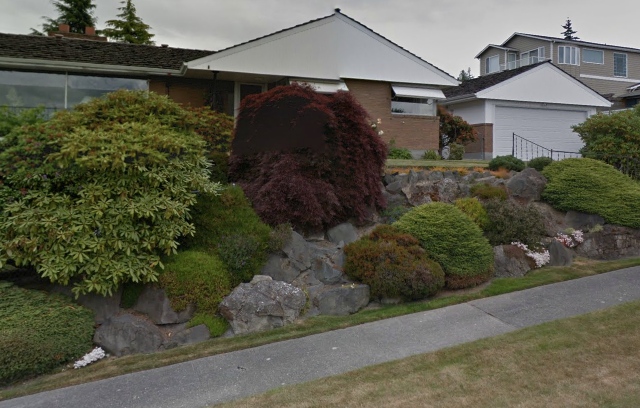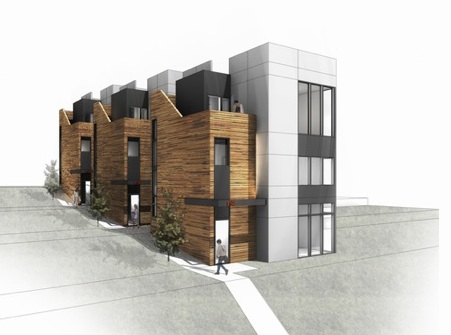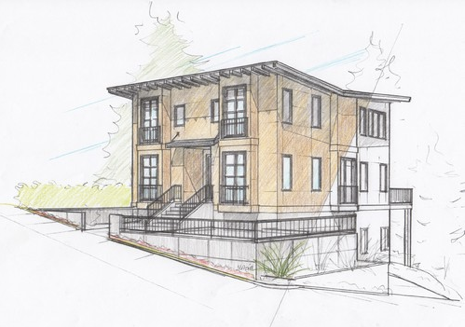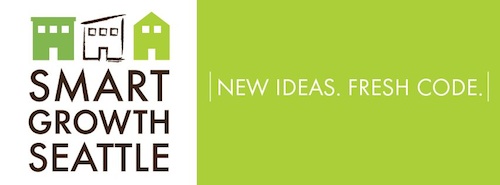KING 5: What’s the Big Story?
Last Friday KING 5 news went out to JMS Homes’ site on 55th and Manning in West Seattle to talk with neighbors and JMS about the project. When Linda Brill the reporter asked me what the big story was I said, “there isn’t one.” I pointed to Bill Richmond the developer of the project and said, “this is just another day at the office for Bill.” Why does such straight forward project attract so much attention? It’s because things are changing in the neighborhood, and change is difficult. But if Seattle is going to grow smart, we’re going to have to learn to change together, and doing that is the big story.
I’ve already covered the facts of the project; it’s smaller than it could have been under the code, it will create a smaller view impact than if the site was fully built out, and there will be three homes on the site rather than two. And the project fits entirely within the “emergency” legislation passed last year.
But let’s take a look at the language in the KING 5 segment. It’s a short piece, but it covers a lot of ground.
Greed or financial responsibility?
One of the neighbors says Bill is greedy. It’s hard to understand how that could be when JMS could have gotten two big houses on the site with more square footage. There is a difference between greed and profit, and it’s unfortunate that the neighbors can’t tell the difference. When developers buy land, they have to meet the basic financial obligation of creating a return on the initial investment, often made with the help of other investors. Creating more value by creating more homes isn’t greed, it’s financially responsible.
Smaller houses on a big lot
The report starts out talking about the “problem” of big houses on small lots, but later in the report you’ll hear about the “ample lots” that prevail in the neighborhood. Remember this lot is already 12,000 square feet. And the houses aren’t big houses, but two smaller houses being built next to the existing house. You’ll hear the reporter say more than once the phrase “three small homes” or “three small houses” which is more accurate than the tease or the headline.
“Knitting together all these loop holes”
The word “loophole” gets thrown around a lot in discussion about development in single-family neighborhoods. There are many senses of the word, but the best definition of what I think the neighbor means is from Wikipedia:
A loophole is an ambiguity in a system, such as a law or security, which can be used to circumvent or otherwise avoid the intent, implied or explicitly stated, of the system.
That’s the opposite of what’s happening here since the developer is actually following the intent of the legislation passed last year, reducing the height of houses so that they fit within the new requirements. And as for “knitting together loopholes,” I would just have to refer that to the metaphor police.
No code change
At one point the reporter suggests that the developer is requesting a “code change.” Strictly speaking a code change is a change to the underlying rule itself, which is very different than submitting a permit to build or a request to sub-divide property. And code changes require a vote of the City Council; the Council isn’t voting on this project.
Which way is the view?
Um, this one is a bit hard to bring up. Take a look at the final image of the famous and eponymous bench of the Benchview Neighborhood.
The bench faces the water and the project site is behind it. You can see the clutch of neighbors talking to the reporter in the background. The view from the bench is going to be just fine.
Neighborhood Density
Finally, Bill points out that he is creating neighborhood density, efficiently creating a housing option for more people in a smaller footprint. It’s only two additional houses, but that’s two families that might have the option of living in Seattle rather than somewhere else, having to commute to work from the suburbs. It’s a small contribution to sustainability, but one that’s worth it even though it means change for the people already living there. That small contribution should be the big story.
Fact Check: Proposed West Seattle Homes Are Neighborly
There is something about land use and housing that provokes a lot of interest and emotion. That’s especially true about new housing in single-family neighborhoods. New housing in any neighborhood means change, and change isn’t always easy to accept.
A project in West Seattle that will add two new homes where there is only one has sparked a lot of comment and discussion over at the West Seattle Blog. Some of the comments aren’t, well, very neighborly.
Some of the concerns expressed in the comments make sense, though: if something is really great, especially a neighborhood, why change it? Why introduce uncertainty into something we already like?
Part of the answer of course is that Seattle is a growing city, with lots of new people moving in who need places to live. Some of those people will want to live in single-family homes, maybe even in West Seattle. These new homes at this property will help meet that need in the city rather than in a sprawling suburb.
Let’s consider one commenter’s concern about the new project:
That is a ghastly proposal. Just because you can do something, doesn’t mean you should! Case in point: we added a floor two years ago to our house, and the city said we could go up 13 feet. That would have made our house tower over all homes on our block. To be neighborly, we kept the rise to only 8 feet. Result? No grumpy neighbors. And an healthy conscience.
But let’s look the facts about the project that is being proposed and see whether it is excessive or a project that actually is smaller than what the code allows.
The project is not, as the Seattle Weekly declares, a “Dan Duffus Development.” The project is financed by Blueprint Capital, sponsor of Smart Growth Seattle, but the property is owned by JMS Homes. That owner and the contractor, All Day Construction, offered to sell the neighbors a view easement over the existing one story home and over one of the two new proposed homes. Offering this kind of easement is not required by the code, but the neighbors declined.
Also important is that the owner is not demolishing the existing home, but preserving it, and building one 22 foot two story home with about 2000 square feet above grade (which is within the limits imposed by the “emergency” legislation passed last year. The second home is three stories and below the 30-foot height limit with about 2800 square feet above grade.
As for the commenter’s worry that the site is being maxed out creating the “grumpy neighbors,” existing code would allow demolishing the old house and the construction of two 5000 square foot homes. That would have an even bigger view impact than what is proposed and be more than twice the square footage. Rather than max out the site with two big houses, the project holds back, allows more views, and supports three homes on the site instead of two; that’s sustainable, efficient, and neighborly.
Call it growing pains: the frustration and anxiety created by new people moving in next door, new construction, and the loss of views. That’s the kind of change that can make people upset, but the truth is that this project isn’t as big as it could be but it does create homes for two more families in what in a neighborhood that people obviously love.
Emotion aside, the project really isn’t excessive at all, but meets the standards of legislation intended to help make new development more predicable and fit into existing patterns of development.
Image from Google Maps
Smart Growth Seattle to Promote Neighborhood Density at Downtown Events
Smart Growth Seattle, a new group advocating for more housing choice in Seattle, kicks off the New Year with two back-to-back panels to talk about the importance of smart growth in Seattle’s single-family neighborhoods.
First, Dan Duffus will be a panelist at an event on Wednesday, January 23rd sponsored by the Urban Land Institutes Northwest Young Leaders Group. The Neighborhood Density Panel will start at 4pm with networking and the panel discussion starts at 4:30.
The discussion will include backyard cottages, cottage housing, multi-unit lots, and new development in Seattle’s single-family neighborhoods. Additionally, the panel will cover new legislation, how to successfully build new housing in single-family neighborhoods, and strategies for engaging neighborhoods.
Along with Smart Growth Seattle’s Dan Duffus the panelists include Richard Conlin, Seattle City Councilmember and Chair of the Planning, Land Use, and Sustainability (PLUS) Committee, Mike Podowski with the City’s Department of Planning & Development, and Gabe Rosenshine, Owner, Alchemy Real Estate. The panel will be moderated by Anne Vernez Moudon, Professor of Urban Planning at University of Washington.
The ULI panel will be at GGLO’s Space at the Steps, 1301 First Avenue in Seattle.
The following afternoon, Smart Growth Seattle will participate in a similar panel discussion at Great City’s regular brown bag lunch series, in the same space at GGLO. Great City urges attendees to “bring your lunch, your questions for our presenters, and your sense of vision for Seattle.” Great City’s brown bag lunch events are free and open to the public. They typically take place 2nd and 4th Thursdays of every month from 12:00pm to 1:30pm
Event Details:
Urban Land Institute: Neighborhood Density Panel
When: Wednesday, January 23
4:00 – 4:30 PM Registration & Networking
4:30 – 6:00 PM Panel Discussion
Where: GGLO Space at the Steps
1301 First Avenue
Seattle, WA
Great City Brown Bag Lunch: Single Family Style
When: Thu, Jan 24, 2013 12:00 PM – Thu, Jan 24, 2013 1:30 PM
Where: 1301 1st Avenue, Seattle, WA (About 1/4th of the way down the Harbor Steps)
Image from Blueprint Capital
American appetite for big homes is falling
Trulia released some very compelling charts and graphs based on opinion research suggesting the demise of the McMansion — the huge, mass-produced housing form associated with sprawl. That’s an encouraging sign for policy makers considering new options for smaller, greener homes inside the city in existing single-family neighborhoods.

Less than 10 percent of Americans consider the McMansion — defined by Trulia as 3,200 square feet or larger — as being the ideal home size. Not all big houses are McMansions, however. Trulia is talking here about big houses, all built at once, and sprawling out. It’s the kind of housing form you’d expect in, say, Texas. But a story on CNBC had these two paragraphs:
Diane Cheatham, owner of Urban Edge Developers in Dallas, said today, the average size of home they’re building is 2,200 square feet, down from 2,500 in 2005 — which was considered small for Dallas back then.
She said the trend there is more toward building green homes instead of big homes. Right now, they’re building a 1,200-square-foot uber-green home for a couple that’s downsizing from 3,000-square feet, Cheatham explained.
And here we were thinking everything was bigger in Texas. There isn’t any clear consensus about why this is happening, though it seems certain that the economy — and unemployment in particular — has a role:
But as the economy recovers, we know density and smaller homes are better than mega houses connected by vast networks of highways. What if we made the best of this situation by creating some policies to make it more economical to live inside urban growth boundaries?
That’s why finalizing small lot legislation in Seattle is so important. Legislation that was passed last year to resolve the “emergency” about development of historic lots is actually a great opportunity to collaboratively address issues with new housing in single-family neighborhoods. There is a growing demand for smaller, more efficient homes and Seattle should be ready to build them.
This post adapted from a post written by the author that originally appeared at Sightline’s Daily Score blog.
Image from Blueprint Capital
A New Voice for Smart Growth in Seattle
Late last year a group of developers and smart growth advocates got together to talk about ways to positively affect growth in Seattle. Where, they asked, is the positive voice for new housing in single-family neighborhoods? Lots of work is going on to build new housing around light rail and to support zoning to accommodate more growth in neighborhoods zoned for multi-family. But there really wasn’t much of an active voice finding new ways to grow in our city’s other neighborhoods, single-family.
So Smart Growth Seattle was formed. Smart Growth Seattle is a new advocacy group promoting fresh land use codes to manage neighborhood growth. We collaborate with homebuilders and community stakeholders to help government adopt codes that are appropriate for meeting housing demand and preserving neighborhood character. Our approach starts by identifying ways that the land use code can be improved. We collect ideas relevant to these initiatives and weigh them against a set of principles shared among our supporters. Then, we communicate with government officials to help them enact the smartest solutions.
You can watch this site for the latest on our initiatives, speaking events, and other information related to how we, in the words of former Mayor Paul Schell, grow with grace; welcoming new people to all our neighborhoods while maintaining and enhancing the character of those neighborhoods at the same time.








